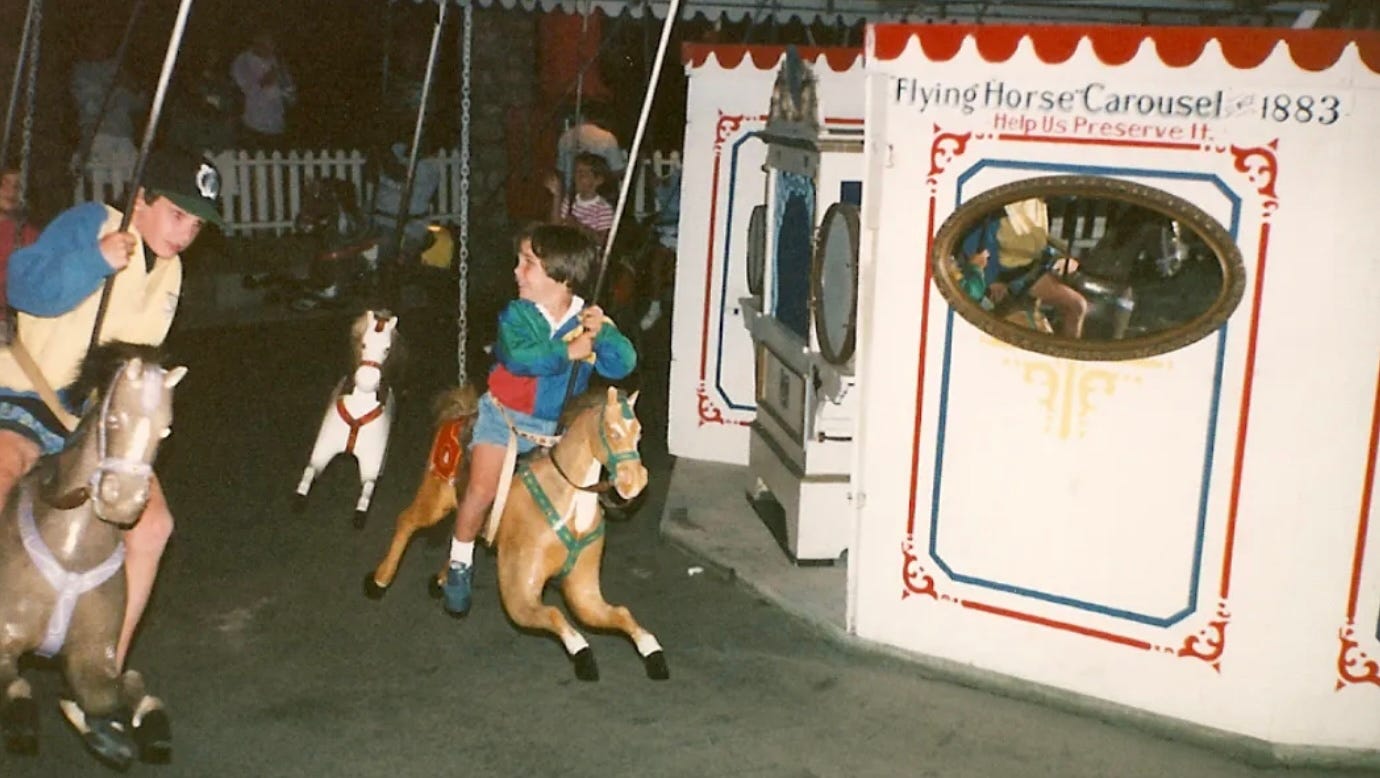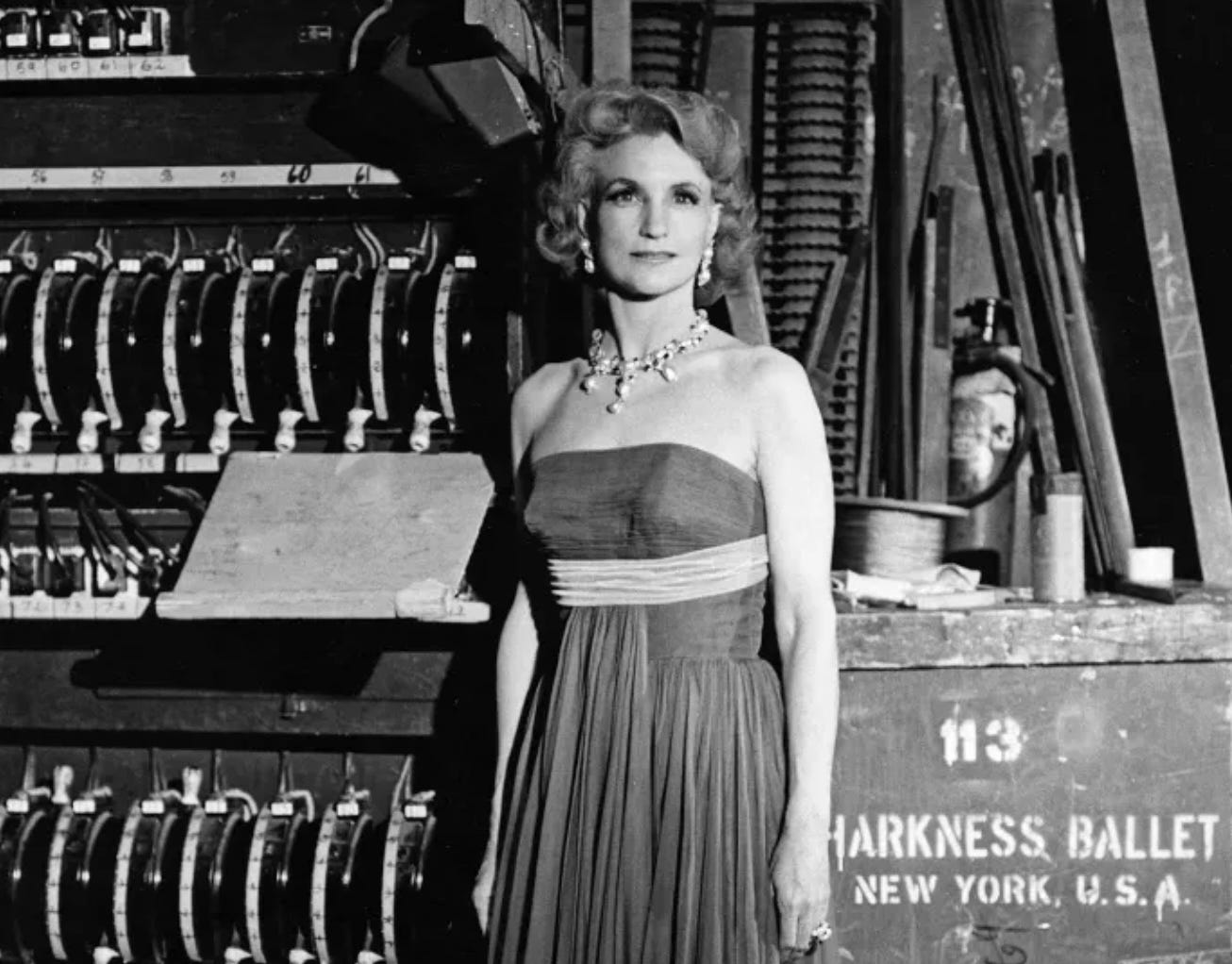The beach town, the pop star, and me
The Rhode Island neighborhood Taylor Swift and I both love
Note: This week, I’m experimenting with Substack’s “voiceover” function, in which I can embed an audio version of the post — read by me — up at the top for your listening pleasure. Particularly for this post, there are some audio elements (music, ambient sounds, etc) that might help the words flourish (I can’t vouch for my shoddy narration, however). I’m also happy to report that in addition to listening here or in the Substack app, you can also subscribe to You Are Here as a podcast on Spotify, Apple Podcasts, Overcast, and PocketCasts.
That said, you should feel free to take in this post however you’d like; the writing will continue to be the center of this work, and the pod is merely meant to be a new way to experience it. Cheers!
When I was a little kid, my family took yearly vacations at a beach house in southern Rhode Island, on Atlantic Avenue in Westerly. We rented the house with close family friends, and our time together — with each other, with the land and the ocean, and with the house itself — forms a huge basis of the chunk of my memory dedicated to childhood summers. I can’t think of being a kid in the Rhode Island summer heat without reliving unsupervised runs to the Weekapaug Inlet for the daily haul of candy, only a fraction of which our parents knew about (sorry to break it to you, guys), or the pillow forts we built in the upstairs living room (attic?) of our rental. I even recall with a strange fondness the three-inch splinter I got in my foot while ill-advisedly running on the wooden deck back from the beach. My mom told me I was so brave. I was so not.
Just down the road from the Weekapaug house was another neighborhood in Westerly called Watch Hill. In many ways it was, and remains, a typical affluent beach town: shops selling $400 beach hats to be worn twice a year; specialty ice cream with over a hundred flavors; and truly enormous high-society beachfront homes that towered over us as we rode our bikes past. In addition to undeniable beauty, these homes radiated mystery, majesty, and intrigue: what could one person ever do with such limitless space? What manner of man or woman could ever hope to afford such a thing?
Although my family (and most families, let’s be clear) could never have afforded to live in Watch Hill, we settled for visiting a couple times a summer. And even without the beachfront views, I’m left with memories of Watch Hill that are as etched in my brain as any from my childhood. Take the Flying Horse outdoor carousel, built in the 1880s, and abandoned in Watch Hill after a traveling carnival went bankrupt. It was originally powered by (rather ironically, I might add) a horse walking in circles. A National Park Service historic places application reports that by the turn of the 20th century, “horsepower gave way to waterpower, which, in turn, was replaced, about 1914, by electricity.”
The carousel features an outer track of horses that the “big kids” could ride in an attempt to reach out and nab one of the metal rings fed through a chute along the outside of the carousel. The big prize was a brass ring which, if snagged, wins you a free ride. There’s also an inner track for the little ones, like me (see below). Our family stopped regularly visiting Watch Hill before I was old enough to really try for the brass ring. I think we can just assume that, if permitted, I would have nailed it, first try.

There’s also the statue of Chief Ninigret, sachem of the eastern Niantic Indian tribe in the 1600s at the time of colonization. Like many New England indigenous tribes of that era, Ninigret and his people had a fraught and complicated relationship with the European settlers, and was often pitted against other tribes in the area in ways that (surprise) ended up mostly benefitting the settlers in the long run. Not so surprising, then, that when a Puritan leader asked permission to preach for Ninigret’s tribe, Ninigret replied: “Go and make the English good first.”1 Rude, but fair.
These days, however, Chief Ninigret and the Flying Horse Carousel have been long since displaced as the key landmark of the modern Watch Hill community. About a decade ago, no less a star than Taylor Swift introduced a new layer of lore to the neighborhood by purchasing an 11,000-square-foot home for $17.8 million in the southwest corner of Watch Hill, overlooking Block Island Sound. Swift made the purchase—all in cash, apparently—on the heels of the world tour for her album Red, just as she was beginning her final approach on what, at the time, was the apex of her fame. Other celebrities who frequented the area—like Conan O’Brien, who lives a few doors down from Swift in the summer—soon barely warranted a double-take if spotted at Olympia Tea Room in old town Watch Hill. Swift seemed to know what she was getting into, setting up shop in such a conspicuous property. In the early days of her residency, she adorned her beachfront property line with a sign reading “I knew you were trouble when you walked in. NO TRESPASSING.”
The chaotic fame machine that would follow Swift over the next few years was something to behold, and much of it unfolded at the property known as High Watch. Her legendary Fourth-of-July shindigs became the most sought-after party invitation in the world. Mid-2010s celebrities like Lena Dunham, Emma Stone, and Andrew Garfield flew in from hither and yon to hang out. Ryan Reynolds, Blake Lively, and some Jonas brothers made appearances. In the summer of 2016, the legend of Hiddleswift shot into the sky then quickly exploded like a firework at one of Taylor’s Fourth of July blowouts. At least we got “Getaway Car” out of it.
The heyday of the High Watch Party Era spanned the years that Swift was 23 through when she was 26. She was at the peak of her fame (or so we thought), and yet—as it tends to at that age—so much of it came crashing down. Overexposure reared its ugly head. The feud with Kanye West reached a fever pitch. Her relationships became, yet again, the driver of her narrative in lieu of all the Grammys and artistic praise she received for her groundbreaking 1989 album. Instead, she got in her head, as we all do when confronted by much less. By her own admission, she “hosted parties and starved [her] body,” developing an eating disorder and deciding, by the end of 2016, to shut it all down. Under the hot lights of the press and the east coast summer sun, the biggest star in the world disappeared from public life for many months.
This origin story gave us reputation (2017), an album whose jagged edges were etched by the burn of a very public death and rebirth. Swift could have been forgiven for running for her life from Watch Hill, fleeing the locational embodiment of her very public persona. And yet, to celebrate its release, Swift hosted a secret listening party in her own home—the lore-laced one in Rhode Island—with a few of her most dedicated fans. Despite the extracurricular nonsense that had come with simply making award-winning music and buying a house, at such a clear hinge-point in her life and career, Taylor Swift still loved her summer sanctum in the classic American beach town. After all, the eye of the storm is the calmest part.
During this same period in the mid-2010s, I, too, was going through a time of unique change. You see, we’re essentially identical, Taylor and I: she was winning her second Grammy for Album of the Year, dating Marvel superheroes, and scoring her third straight number one hit; meanwhile, I was deciding I didn’t really like hanging out with lobbyists, and went back to school rather than continue to do fundraising for Rhode Island Democrats who, let’s face it, would raise plenty of cash without me.
In 2014, I decided to go get my PhD at the University of Maryland, and finally left Rhode Island after 24 years. As the cliché goes, it was bittersweet. It probably won’t shock you to learn that this departure came with lots of reflection, stock-taking, score-settling, and loop-closing, none of which is ever quite as tidy or satisfying as one might hope. I spent much of my last summer in Rhode Island biking around the state and taking in all the spots that had meant something to me (it’s a small state, so you can knock out the whole trip in a couple days). Watch Hill was the farthest I could go without accidentally ending up in Connecticut, and so I went. It seemed so much smaller than it had when I was a kid, the Flying Horse carousel so much less daunting — much less daunting than Taylor’s house on the corner, anyway. I looked, I took mental (and actual) photos, I made a note or two. And, a little begrudgingly, I left.
I was finally, reluctantly, entering a delayed adulthood by leaving the place I grew up. During my childhood and adolescence in my hometown in Woonsocket; my college education in Providence; and my recent job as a political consultant, I had learned all there was to know—the good, the bad, the ugly—about the politics, people, and culture of the state I still, to this day, identify with the most. Leaving such a special place meant accepting that all places, all bustling cities, and all beloved home states—no matter how small and cozy—have their rainbows, and have their scars.

Summers, and summer places, help us take in that big picture. The days are long, the cares are free, and the time is ours to look backward and look forward in the middle of another long year. Taylor had her hinge points in Watch Hill; and that summer, I had mine there too. This lovely, quite useful unmooring that summers can provide is I think best captured in this stanza from one of my favorite poems by the late John Updike — who, incidentally, shares a birthday with Taylor Swift — called “The Long Shadow.”
Why do we love them, these last days of something
like summer, of freedom to move in few clothes,
though frost has flattened the morning grass?
They tell us we shall live forever. Stretched
like a rainbow across day's end, my shadow
makes a path from my feet; I am my path.
Six years and one PhD later, I have to admit that Taylor Swift and her career, her “eras”, and certainly her living situation had flown more or less beneath my radar. I knew the hits; I liked them; and I had been vaguely aware that she bought a house in Rhode Island. But since I was on my way out the door around that time, the fact didn’t exactly get top billing in my brain.
That changed during the summer of 2020 —that lovely time — when Swift released folklore, an Indie-folk album and hard-left turn sonically, not just from her previous record, Lover, but from pretty much all her previous work. I’ll cop here to the fact that my first listen was, in no small part, a bid to win over the massive Swiftie who is now my wife; who at the time I had only been dating for a few months; and who was probably still making up her mind about whether I was worth the trouble. I knew that she was, though; so giving Taylor Swift a real chance was the only proper course.
I was rewarded for these courting efforts; not just because Keara ended up liking me enough to marry me, but because folklore is an honest-to-god masterpiece that went on to win Swift her third Grammy Award for Album of the Year, and has become the one true pandemic record.
For me, the clincher arrived in the album’s third track, “the last great american dynasty.” Specifically, my ears perked up at two unexpected words — “Rhode Island” — that caught me mainly because I don’t often hear them anymore outside of family chats. The song offers us a brief history lesson about Swift’s magnificent property in Watch Hill that we’ve just been learning about. And so, instantly, Taylor Swift transformed from a pop culture abstraction to someone who felt personal because of a shared summer space that we really did have in common.
Before it belonged to the world’s biggest pop star, 16 Bluff Ave had been dubbed “Holiday House” by the wealthy Standard Oil Company heirs who had the place built in the early 1900s. Rebekah Harkness — the main subject of Taylor’s song — was an eccentric divorcee who married into the family, and became the surviving heiress to the Standard Oil fortune when her husband died in the 1950s. Her undeniably creative attention-getting antics reportedly included cleaning the property’s pool with Dom Pérignon champagne; lacing punchbowls at nearby parties with mineral oil; and performing stripteases on banquet tables with her friends. “She had a marvelous time/ruining everything,” Swift writes in “the last great american dynasty.” Harkness reveled in her role as the center of high society, apparently determined to confound her contemporaries’ expectations at every possible opportunity.
In telling Harkness’s story, Swift analogizes herself along the way, laying bare the power of one person to change a community, the culture, and their own reputation. Sometimes that change is for the better; sometimes, the worse; sometimes, the strange. Rebekah Harkness, for all her contributions to art and high society, was apparently never quite able to exercise a ton of control over her reputation. Her personal experience was marked with divorces, suicides, and even murders, as she muddled her way through later life as a creative but ultimately aimless heiress.
Things have gone quite differently for Taylor Swift. folklore marked the beginning of a career renaissance, and — along with the three albums and record-shattering tour that have come since — catapulted her to a singular place atop the culture. She famously remarked during the peak of the Kanye West/Kim Kardashian feud in 2016 that she “would very much like to be excluded from this narrative.” These days, Swift masterfully spins her own narrative by meticulously running her business; multiplying her creative output; fighting to own her old music outright; and, ultimately, controlling her own destiny. Long shadows are cast in summer places, John Updike writes; and our own shadow becomes our path. I would never want to be Taylor Swift — the chaos, the lack of privacy — but that path sure does sound empowering.
Good places, reliable places — and yes, especially those fleeting summer places — can help us do that. Watch Hill helped me do that in youth, and at a major crossroads in my life. Taylor too, apparently. It’s a fun little treasure for me, sharing a very special town and the briefest of historical overlaps with the biggest star of her generation — which, incidentally, is also my generation. My memories of Watch Hill, of the deepest lived experience I have there, are long past; but according to John Updike, each year’s summer days “tell us we shall live forever.” I’ll try.









Long Live the watch hill carousel 🎠 RI beach summers were certainly a special era in my life.
Fun overlaps! I’m sorry to say I’m a bit indifferent to Taylor Swift’s music though definitely respect her and am fascinated by the phenomenon of her stardom—but I liked how you described the moment when she became a real person for you during to that geographical commonality. I’ve experienced that in other settings and maybe it would be enough to make TS a bit more relatable to me as well.